KTM ETS
| KTM ETS KTM Electric Train Service | |
|---|---|
|
ETS | |
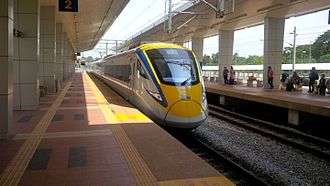 | |
| Overview | |
| Native name |
Perkhidmatan Tren Elektrik (Malay) 电动列车服务 (Chinese) மின்சார ரயில் சேவை (Tamil) |
| Type | Inter-city rail - Higher-speed rail |
| Locale | Padang Besar - Butterworth - Ipoh - Kuala Lumpur - Gemas - (Johor Bahru 2022) |
| Stations | 44 (as of 2017) |
| Daily ridership | 10,880 (Second half 2018)[1] |
| Ridership | 4.148 million (2017) [1] |
| Website |
www |
| Operation | |
| Opened | August 2010 |
| Owner | Keretapi Tanah Melayu Berhad (KTMB) |
| Operator(s) | KTM Intercity Division |
| Conduction system | With driver |
| Rolling stock |
5 six-car trainset of KTM Class 91 10 six-car trainset of KTM Class 93 |
| Technical | |
| Line length |
Current: 755 km (Padang Besar-Gemas) Under construction: Additional 197 km (Gemas-Johor Bahru Sentral) |
| Track gauge | 1,000 mm (3 ft 3 3⁄8 in) metre gauge |
| Operating speed | 140 km/h (87 mph) |
KTM ETS route network | |||||||||||||||||||||||||||||||||||||||||||||||||||||||||||||||||||||||||||||||||||||||||||||||||||||||||||||||||||||||||||||||||||||||||||||||||||||||||||||||||||||||||||||||||||||||||||||||||||||||||||||||||||||||||||||||||||||||||||||||||||||||||||||||||||||||||||||||||||||||||||||||||||||||||||||||||||||||||||||||||||||||||||||||||||||||||||||||||||||||||||||||||||||||||||||||||||||||||||||||||||||||||||||||||||||||||||||||||||||||||||||||||||||||||||||||||||||||||||||||||||||||||||||||||||||||||||||||||||||||||||||||||||||||||||||||||||||||||||||||||||||||||||||||||||||||||||||||||||||||||||||||||||||||||||||||||||||||||||||||
|---|---|---|---|---|---|---|---|---|---|---|---|---|---|---|---|---|---|---|---|---|---|---|---|---|---|---|---|---|---|---|---|---|---|---|---|---|---|---|---|---|---|---|---|---|---|---|---|---|---|---|---|---|---|---|---|---|---|---|---|---|---|---|---|---|---|---|---|---|---|---|---|---|---|---|---|---|---|---|---|---|---|---|---|---|---|---|---|---|---|---|---|---|---|---|---|---|---|---|---|---|---|---|---|---|---|---|---|---|---|---|---|---|---|---|---|---|---|---|---|---|---|---|---|---|---|---|---|---|---|---|---|---|---|---|---|---|---|---|---|---|---|---|---|---|---|---|---|---|---|---|---|---|---|---|---|---|---|---|---|---|---|---|---|---|---|---|---|---|---|---|---|---|---|---|---|---|---|---|---|---|---|---|---|---|---|---|---|---|---|---|---|---|---|---|---|---|---|---|---|---|---|---|---|---|---|---|---|---|---|---|---|---|---|---|---|---|---|---|---|---|---|---|---|---|---|---|---|---|---|---|---|---|---|---|---|---|---|---|---|---|---|---|---|---|---|---|---|---|---|---|---|---|---|---|---|---|---|---|---|---|---|---|---|---|---|---|---|---|---|---|---|---|---|---|---|---|---|---|---|---|---|---|---|---|---|---|---|---|---|---|---|---|---|---|---|---|---|---|---|---|---|---|---|---|---|---|---|---|---|---|---|---|---|---|---|---|---|---|---|---|---|---|---|---|---|---|---|---|---|---|---|---|---|---|---|---|---|---|---|---|---|---|---|---|---|---|---|---|---|---|---|---|---|---|---|---|---|---|---|---|---|---|---|---|---|---|---|---|---|---|---|---|---|---|---|---|---|---|---|---|---|---|---|---|---|---|---|---|---|---|---|---|---|---|---|---|---|---|---|---|---|---|---|---|---|---|---|---|---|---|---|---|---|---|---|---|---|---|---|---|---|---|---|---|---|---|---|---|---|---|---|---|---|---|---|---|---|---|---|---|---|---|---|---|---|---|---|---|---|---|---|---|---|---|---|---|---|---|---|---|---|---|---|---|---|---|---|---|---|---|---|---|---|---|---|---|---|---|---|---|---|---|---|---|---|---|---|---|---|---|---|---|---|---|---|---|---|---|---|---|---|---|---|---|---|---|---|---|---|---|---|---|---|---|---|---|---|---|---|---|---|---|---|---|---|---|---|---|---|---|---|---|---|---|---|---|---|---|---|---|---|---|---|---|---|---|---|---|---|---|---|---|---|---|---|---|---|---|---|---|---|---|---|---|---|---|---|---|---|---|---|---|---|---|---|---|---|---|---|---|---|---|---|---|---|---|---|---|---|---|---|---|---|---|---|---|---|---|---|---|---|---|---|---|---|---|---|---|---|---|---|---|---|---|---|---|---|---|---|---|---|---|---|---|---|---|---|---|---|---|---|---|---|---|---|---|---|---|---|
| |||||||||||||||||||||||||||||||||||||||||||||||||||||||||||||||||||||||||||||||||||||||||||||||||||||||||||||||||||||||||||||||||||||||||||||||||||||||||||||||||||||||||||||||||||||||||||||||||||||||||||||||||||||||||||||||||||||||||||||||||||||||||||||||||||||||||||||||||||||||||||||||||||||||||||||||||||||||||||||||||||||||||||||||||||||||||||||||||||||||||||||||||||||||||||||||||||||||||||||||||||||||||||||||||||||||||||||||||||||||||||||||||||||||||||||||||||||||||||||||||||||||||||||||||||||||||||||||||||||||||||||||||||||||||||||||||||||||||||||||||||||||||||||||||||||||||||||||||||||||||||||||||||||||||||||||||||||||||||||||
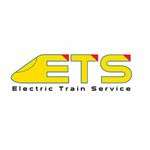
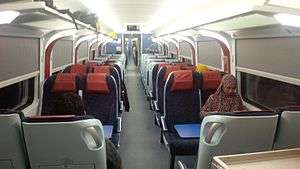
The KTM ETS (commercially known as ETS, shortform for 'Electric Train Service') is an inter-city rail service operated by Keretapi Tanah Melayu Berhad utilizing electric multiple units. The KTM ETS is the second electric train service to be operated by the Malaysian railway company, after the KTM Komuter service.
Commencing in August 2010, the ETS is the fastest metre gauge train service in Malaysia (and potentially in the world, see below) and operates along the electrified and double-tracked stretch of the West Coast Line between Gemas and Padang Besar on the Malaysia-Thai border by the Malaysian national railway operator, Keretapi Tanah Melayu.
The rail service is currently operated by KTM Intercity Division. It was previously operated by ETS Sendirian Berhad, a fully owned subsidiary of Keretapi Tanah Melayu Berhad.
Train services
Routes
The ETS covers the section of the West Coast Main Line between Padang Besar on the Malaysia-Thailand border and Gemas on the border between Negeri Sembilan and Johor, including the branch between Bukit Mertajam and Butterworth. The line from Gemas to Johor Bahru is currently a single line and being double tracked and electrified.
The ETS operates 5 routes, namely:
- Kuala Lumpur(KL Sentral)-Ipoh
- Kuala Lumpur(KL Sentral) - Butterworth
- Kuala Lumpur(KL Sentral) - Padang Besar
- Gemas - Padang Besar via Kuala Lumpur(KL Sentral) and Ipoh
- Gemas - Butterworth via Kuala Lumpur(KL Sentral) and Ipoh
Currently, there 8 return trips on the KL Sentral-Ipoh route, 5 return trips on the KL Sentral-Butterworth, 4 return trips on the KL Sentral-Padang Besar route and 1 return trip each on the Gemas-Padang Besar and Gemas-Butterworth routes daily.
The latest timetables for the routes are available in the KTM Bhd website.
Classes
The train services are operated in 3 categories:
- Platinum service with limited stops
- Gold service with selected stops
- Silver service with stops at all stations.
Ridership
| KTM ETS Ridership[1][2] | |||
|---|---|---|---|
| Year | Ridership | Revenue (MYR) | Remarks |
| 2018 | 1,952,000 | 83,779,008 | Statistics for First half |
| 2017 | 4,148,000 | 174,433,140 | |
| 2016 | 3,565,000 | 145,521,561 | |
| 2015 | 2,059,000 | 60,314,988 | |
| 2014 | 1,693,000 | 44,328,039 | |
| 2013 | 1,563,000 | 40,621,860 | |
| 2012 | 1,180,000 | 31,885,949 | |
| 2011 | 913,000 | 24,313,451 | |
| 2010 | 215,000 | 5,569,532 | Operations began in August |
History
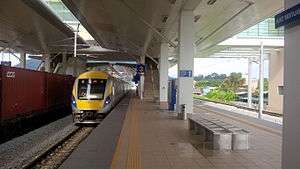

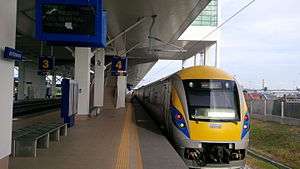
First phase
The service was introduced by Keretapi Tanah Melayu on 12 August 2010 between Ipoh and Seremban following the completion of the electrification and double-tracking of the Rawang to Ipoh stretch of the West Coast Line. Services were then progressively extended to other sections of the West Coast Line when subsequent electrification and double-tracking works were completed, although the KL Sentral-Seremban sector was taken out of service in October 2012.[3]
Second phase
The service was extended from Ipoh to Padang Besar via Butterworth, the mainland town opposite George Town, with the introduction of the ETS Transit on 10 July 2015, with stops at 24 stations. At the inception of service, only one train service in both directions were introduced. This service was given the name ETS Transit.
On the following day on 11 July 2015, a new service called the ETS Express between KL Sentral and Padang Besar, via Butterworth was introduced, with stops at 15 stations. Again, only one service for both directions were introduced[4] although, subsequently, on 1 September 2015, an addition service between KL Sentral and Butterworth was introduced.[5]
Third phase
On 10 October 2015, the ETS service was extended southwards from KL Sentral to Gemas with the introduction of a new service between Padang Besar and Gemas.[6] The extension of the KTM ETS service to Gemas utilizes the electrified double-track between Seremban and Gemas which was completed in 2014. This extension of service also saw the KTM ETS service returning to Seremban after being discontinued in 2012.
Also on 10 October 2015, a new service was launched between Butterworth and Padang Besar in addition to existing services but this service was subsequently reduced in frequency and ultimately terminated, with the introduction of the KTM Komuter Northern Sector.[7]
There were constant revisions of timetables and services as more trains became available, with more train service being added for each of the route segments. The Platinum, Gold and Silver service classes were also reintroduced while the terms "ETS Ekspres" and "ETS Transit" were no longer used.
Rolling stock
| Class | Image | In service | Cars per Set | On order | Manufacturer |
|---|---|---|---|---|---|
| KTM Class 91 | 4 | 6 | N/A | Hyundai Rotem | |
| KTM Class 93 | .jpg) |
10 | 6 | 9 | CSR Zhuzhou |
First Generation
Five KTM Class 91 train sets, each comprising six cars, were purchased by Keretapi Tanah Melayu Berhad for $67 million (USD). The train sets were designed by Marubeni Corporation and jointly built by Hyundai Rotem of Korea and Mitsubishi Electric of Japan.[8] The maximum operational speed of the ETS fleet is 140 km/h but is designed to travel up to 160 km/h.[9] The total length of each train set is 138 m and weighs 231.8 tons. Each carriage is 22.95 m long, 2.75 m wide and 4 m high.[10] Each train set has a passenger seating capacity of 350 and includes on-board facilities including toilets, a buffet car, power sockets per two seats and two LED Televisions per car.
Second Generation
Ten sets of KTM Class 93 trains are in the process of being commissioned to expand ETS service.
The rolling stock were to have been put into operation for the launch of the ETS Ekspres service between KL Sentral and Padang Besar, and the ETS Transit service between Ipoh and Padang Besar. However, reports of problems during the testing and commissioning of the train sets had resulted in the Malaysian land public transport regulator, SPAD, not approving the trains for use in time for the launch of the two services on 10 July 2015 and 11 July 2015.[11]
As a result, two KTM Class 91 train sets were used for some time, one for the ETS Ekspres, and the other for the ETS Transit, allowing for just one trip for each direction for both services.
The first four KTM Class 93 sets went into service mainly on the ETS Ekspres route on 10 October 2015.
Fastest metre-gauge trains in the world
The ETS trains travel up to 145 km/h (89 mph) on electrified metre gauge rail line which can be considered as higher speed rail (HrSR) based on passenger rail terminology instead of high speed rail (HSR).
The speed is similar to that of the Kamome Express and Sonic Express in Japan, the Taroko Express and Puyuma Express in Taiwan, and the Tilt Train service in Australia. However these services use the 1,067mm (3 ft 6 in) gauge.
In view of this, there is high possibility KTM ETS service is the only one inter-city rail line recorded in the world using 1,000 mm (3 ft 3 3⁄8 in) metre gauge at maximum speed of 145 km/h.
Proposed extension
There are plans to extend the Electric Train Service lines in the future; Gemas to Johor Bahru, Gemas to Tumpat, as well as Padang Besar to Hat Yai.
Gallery
- KTM Class 91 at Ipoh.
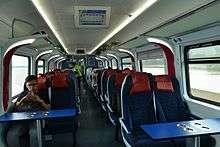 Interior of KTM Class 93
Interior of KTM Class 93 New rolling stock of KTM Class 93 ETS 201.
New rolling stock of KTM Class 93 ETS 201.
See also
References
- 1 2 3 "Statistic for Rail Transport" (in Malay and English). Ministry of Transport, Malaysia. Retrieved 26 September 2018.
- ↑ "Transport Statistics Malaysia 2017" (PDF) (in Malay and English). Ministry of Transport, Malaysia. Retrieved 2018-09-26.
- ↑ "Recent scheduling ETS Services". KTM Intercity. Retrieved 18 November 2012.
- ↑ "KL-Padang Besar electric train starts run today". The Star. 10 July 2015. Retrieved 19 July 2015. External link in
|publisher=(help) - ↑ "Kenyataan Media:Penstrukturan Jadual Waktu Tren Intercity dan ETS Bermula 1 September 2015 (Restructuring of the Timetable for Intercity dan ETS Trains beginning 1 September 2015)" (PDF). KTM Berhad. Archived from the original (PDF) on 5 September 2015. Retrieved 16 October 2015.
- ↑ "Kenyataan Media:Penstrukturan Jadual Waktu Tren Intercity dan ETS Bermula 10 Oktober 2015 (Restructuring of the Timetable for Intercity dan ETS Trains beginning 10 October 2015)" (PDF). KTM Berhad. Archived from the original (PDF) on 6 November 2015. Retrieved 16 October 2015.
- ↑ "KTM BERHAD". www.ktmb.com.my. Retrieved 2017-09-10.
- ↑ "Marubeni Gets $67 Million Malaysia Train-Car Order, Nikkei Says". Bloomberg. Bloomberg. 26 October 2008.
- ↑ "Electric trains to reduce travel time". The Star. Central. 24 August 2010.
- ↑ "Electric Train Set". Malaya Railway.
- ↑ Meng Yew Choong (19 July 2015). "Manufacturer working hard to solve issues with new ETS sets before official handover". The Star. Retrieved 20 July 2015. External link in
|publisher=(help)